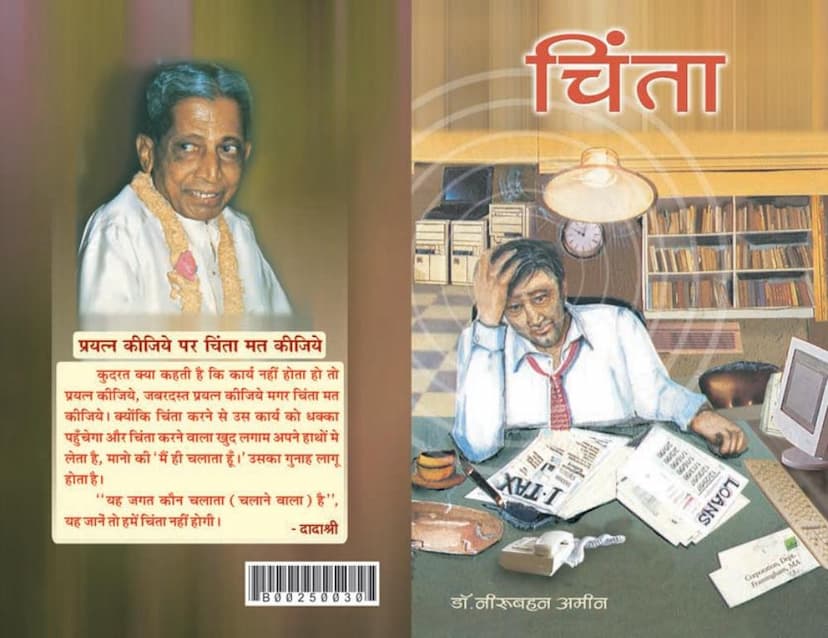Chinta
Added to library: September 1, 2025

Summary
Here's a comprehensive summary of the Jain text "Chinta" (Worries) by Dada Bhagwan, based on the provided pages:
Book Title: Chinta (Worries) Author: Dada Bhagwan (as conveyed through Dr. Niruben Amin) Publisher: Mahavideh Foundation
Core Message: The central theme of the book is to understand the nature of worries (Chinta), their causes, and how to transcend them to achieve inner peace and liberation. Dada Bhagwan, through his teachings, emphasizes that worries are a product of ego and the misconception of being the doer.
Key Concepts and Teachings:
- Effort without Worry: Dada Bhagwan advocates for making sincere and strong efforts in any task, but strongly advises against worrying about the outcome. Worrying, he states, creates obstacles to the task and implies taking control (the ego's grip) which leads to negative karma ("gunah lagu").
- Understanding the Controller: The key to eliminating worry is to understand who truly controls the world. If one knows the ultimate controller, they will no longer feel the need to worry.
- Worry as Ego: Worry is explicitly defined as a manifestation of ego (ahamkar). It arises from the false belief that "I am the doer," "I am the owner," and "I am managing all this." This ego leads to the burden of responsibility and subsequent worry.
- The Law of Nature: Nature's law dictates that worrying about a task hinders its completion. Conversely, when one is free from worry, the task tends to resolve itself.
- Worry is Like Fire: Worry is compared to a burning fire that continuously consumes, prevents sleep, disrupts hunger and thirst, invites illness, and even leads to negative rebirths. It spoils both the current and future lives.
- No Independent Doer: The universe operates based on scientific circumstantial evidence ("vyavasthit" or "scientific circumstantial evidence"). There is no independent doer; everything happens as a result of interconnected causes and conditions. When this understanding is absent, one takes on the role of the doer and worries.
- The Difference Between Thinking and Worrying: Thinking is permissible and a natural part of life. However, when thoughts become a constant cycle, leading to mental distress or "suffocation," that's when it turns into worry.
- The Ineffectiveness of Worry: Worry does not solve problems; instead, it exacerbates them. It obstructs work and leads to a reduced outcome (e.g., 70% instead of 100%).
- Animals and Worry: Animals do not worry. Humans, unlike other living beings, are prone to worry due to their advanced ego.
- Faith in God/The Higher Power: True faith in God means surrendering all worries and living peacefully. If God is managing things, why worry?
- The True Path to Worry-Free Living:
- Self-Realization (Atmajnana): The ultimate solution to worry lies in attaining Self-realization, understanding one's true nature as the soul, and realizing that the ego is separate from the Self.
- Understanding "Vyavasthit": Grasping the concept of "vyavasthit" (scientific circumstantial evidence) is crucial. Everything happens according to a divine plan and interconnected causes.
- Letting Go of the Doer-ship: Relinquishing the false notion of being the doer is essential.
- Seeking a Gnani Purush: The teachings strongly emphasize seeking out a living Self-realized being (Gnani Purush) who can impart this knowledge and help in shedding ego and worries.
- Faith and Surrender: Trusting in the divine arrangement and surrendering to it is key.
- Worry and Repercussions: Worrying leads to negative karma and, in the Jain context, can lead to lower realms of existence (like animal births). Worrying is considered a "double punishment."
- The Importance of the Present: One should focus on the present moment and deal with what is available. Worrying about the future or regretting the past is unproductive.
- Ego vs. Normality: "Above normal" ego leads to worry. Normal ego is necessary for the functioning of the world.
- Tension vs. Worry: Tension is similar to worry but involves various stresses without necessarily identifying oneself as the absolute doer. Worry is deeper, where one considers the object of worry as their "all."
- The Role of the Gnani: A Gnani Purush can resolve these worries and anxieties in a short time. The text suggests that after receiving Self-knowledge, worries naturally disappear, leading to constant peace and equanimity (samadhi).
Context and Background:
The book presents the teachings of Dada Bhagwan, an enlightened being who experienced Self-realization in 1958. His teachings are disseminated through his disciple, Dr. Niruben Amin, and published by Mahavideh Foundation. The language used is conversational, presented as a dialogue between Dada Bhagwan and a questioner, making the complex spiritual concepts accessible. The introduction also highlights the lineage of transmission through Dr. Niruben Amin and Pujya Deepakbhai Desai.
In essence, "Chinta" is a guide to understanding and eradicating worries by shifting from an ego-centric, doer-centric perspective to a Self-realized, surrendered, and understanding perspective of the world's workings.